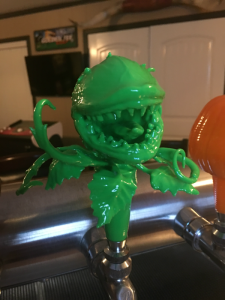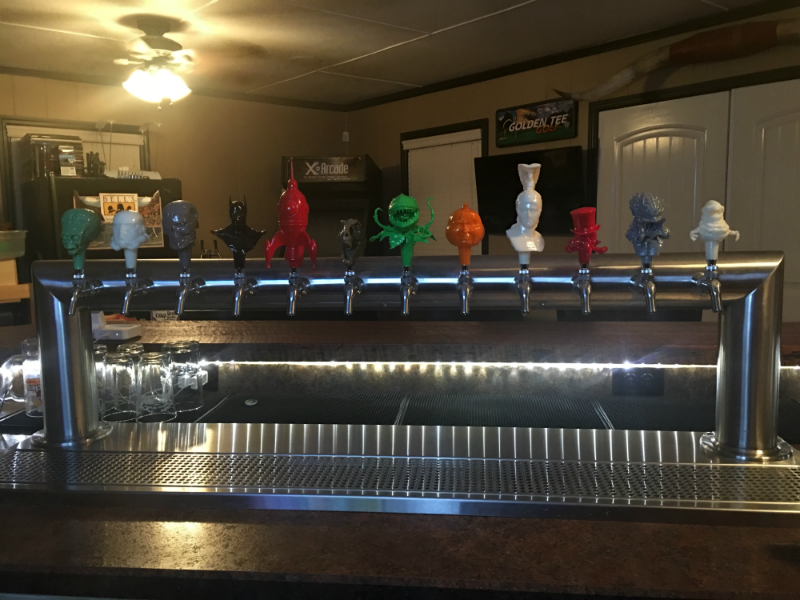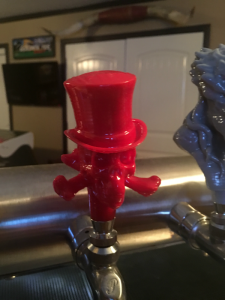Designer’s Private Bar Features 12 Taps with 3D Printed Handles–Stormtrooper, T-Rex, and More Help Pour Beers
 If you know any home brewers out there, or just people who are really into their wet bars, then the idea of customizing through extra beer paraphernalia shouldn’t shock you much. For example, some home brewers create special labels for their beer. But what about some customized 3D printed beer tap handles featuring a range of characters? You’ve seen special beer taps before, right? You really can’t go to a micro-brewery without seeing a dizzying array of custom beer taps for various beverage choices, anymore. Well, “John Beere” has taken this world of the micro-brewery’s customized beer handles and done one better: he designed and 3D printed twelve different beer handles for his home-based private bar. And we have instructions on how he did this just in time to prepare your bar for the upcoming holidays!
If you know any home brewers out there, or just people who are really into their wet bars, then the idea of customizing through extra beer paraphernalia shouldn’t shock you much. For example, some home brewers create special labels for their beer. But what about some customized 3D printed beer tap handles featuring a range of characters? You’ve seen special beer taps before, right? You really can’t go to a micro-brewery without seeing a dizzying array of custom beer taps for various beverage choices, anymore. Well, “John Beere” has taken this world of the micro-brewery’s customized beer handles and done one better: he designed and 3D printed twelve different beer handles for his home-based private bar. And we have instructions on how he did this just in time to prepare your bar for the upcoming holidays!
“Some guys have man caves, I have a private bar.. It is primarily for my homebrew,” Beere noted of his designs.
Beere 3D printed these characters that include Ares, a Rocketship, Audrey II, Slimer, Predator, a Skull and Bones with Top Hat, Angry Pumpkin, T-Rex, Batman, and a Stormtrooper (of course!) on a TAZ 4. He explains he got the models off Thingiverse, and used MeshMixer to design them as taps.
The designs were sliced with Simplify 3D, and the printed characters each got an acetone vapor bath after they were printed. The Audrey II tap handle was his most tedious, he noted, and fully documented the creation process for a reprint of that design. If you’ll notice from the photos, each one of the 3D printed tap handles is is quite shiny. The acetone vapor bath does the trick here, and working with acetone is quite tricky, so Beere summarizes his technique, which works outdoors or indoors (with good ventilation, since acetone smells).
There were many questions about how to work with acetone, and Beere explains his bathing method on a comment thread:
“Acetone boils quick, so the trick is to catch it just as it starts bubbling and turn the heat on low. Wait until the vapors fill the container, and then submerge your print. I usually hold the print in the vapors for 10 seconds at a time, take it out to examine it, the put it back in for 10 second intervals until I’m satisfied. It is important to note that the ABS is very soft after it comes out so you can’t touch it for a few minutes until it hardens.”
Of course, you can always print these beer tap handles without smoothing them with the acetone, but then they wouldn’t be as shiny! With the upcoming holidays, your home-based bar may be in full swing, so why not go for broke and decorate your own (or someone else’s) bar with some 3D printed beer tap handles that are sure to make all the beer drinkers in your life smile. Discuss these designs in the 3D Printed Taps forum on 3DPB.com.
Subscribe to Our Email Newsletter
Stay up-to-date on all the latest news from the 3D printing industry and receive information and offers from third party vendors.
You May Also Like
Precision at the Microscale: UK Researchers Advance Medical Devices with BMF’s 3D Printing Tech
University of Nottingham researchers are using Boston Micro Fabrication‘s (BMF) 3D printing technology to develop medical devices that improve compatibility with human tissue. Funded by a UK grant, this project...
3D Printing Webinar and Event Roundup: April 21, 2024
It’s another busy week of webinars and events, starting with Hannover Messe in Germany and continuing with Metalcasting Congress, Chinaplas, TechBlick’s Innovation Festival, and more. Stratasys continues its advanced training...
3D Printing Webinar and Event Roundup: March 17, 2024
It’s another busy week of webinars and events, including SALMED 2024 and AM Forum in Berlin. Stratasys continues its in-person training and is offering two webinars, ASTM is holding a...
3D Printed Micro Antenna is 15% Smaller and 6X Lighter
Horizon Microtechnologies has achieved success in creating a high-frequency D-Band horn antenna through micro 3D printing. However, this achievement did not rely solely on 3D printing; it involved a combination...






























